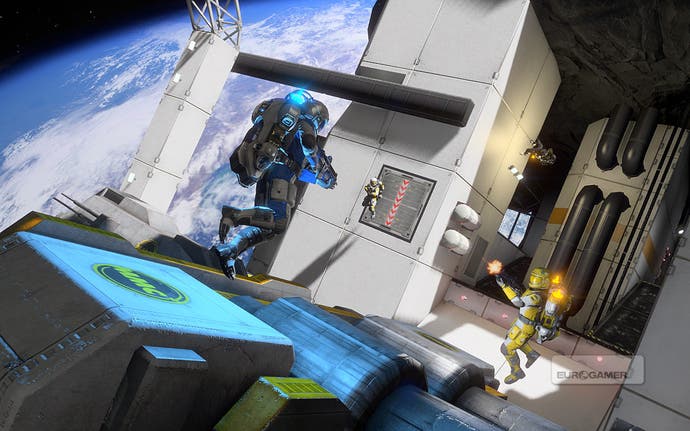Shattered Horizon
Z-Axis granted.
Regarding those physics: you move around with consistent inertia, but you can't accelerate indefinitely. While you use normal FPS controls to move around, with forward propelling you in whichever direction you happen to be facing, you're also able to bind a key or mouse button to "rotate", allowing you to move into whatever alignment you fancy at the flick of a wrist. Since there's no up or down, it doesn't really matter. What matters is that you shoot the enemy astronauts as accurately as possible. This is the other bit where space isn't realistic: you don't go spinning away to burn up in the atmosphere when you get shot, at least not until you're dead. Also, you can hear the enemy weapons as well as your own, which is a bit of a shame, given the beautifully appropriate spacey atmospherics that wrap up the rest of the experience.
The gunplay is a little bit unusual, of course, because you're floating and moving with continuous inertia, which you have to carefully adjust to stop, or to "land" on an asteroid or other surface. The HUD also tracks the trajectories of enemies for a few seconds when they disappear behind cover, which gives you ample opportunity to plot intercepts with less agile opponents. There are also some special projectiles, such as a smoke bomb thing, an EMP blast, and a concussion bomb that can put an end to enemies instantly by bouncing them into deep space. "Bye!"
Even better than shooting is the close-range attack in which you rip open an enemy's space suit, killing him instantly. I've always been too hamfisted to pull that off myself, but I've watched my corpse spin off into the cold night a few times now, and I intend to reap that same pain on someone else, rather soon.
Otherwise the game structure is typical of multiplayer combat games. It's a 32-player affair on dedicated servers. The modes include "Battle" in which the teams struggle to dominate the map via control points, which is fairly typical of this kind of FPS. Then there's "Assault", which gives the point-capturing a turn-based spin. The two teams take turns in attacking and defending, and the points can't be uncaptured once lost to the opposition. This means it's possible to draw if the attacks fail to take the points. Then there's classic deathmatch based purely on kills, as featured in such games for time immemorial.

It's a beta, of course, and that means it's currently burdened by normal beta issues such as occasional glitches, dodgy connections, and the odd mechanical bug, but I've nevertheless been revelling in swooping through the vacuum and watching my enemies (and occasionally myself) going spinning off into space. And they do spin off into space rather wonderfully. When the graphics settings are cranked up it's astonishingly crisp and detailed.
Looking forward, it's clear that this is a game that will, despite being rather accessible, end up appealing to a fairly specific crowd. Astronaut deathmatch is esoteric - there's no escaping it. It's probably going to require extensive building on what we've so far seen in the beta to really capture a significant audience. It's fairly austere in its presentation, and probably needs some more craziness to keep people's attention. Nevertheless, assuming Futuremark can sustain its developmental momentum, this will be one shooter that should be able to reach a stable orbit around the homeworld of gaming interest. Oof, that metaphor was a bit laboured. I'd better go and watch the moon-bombing.








